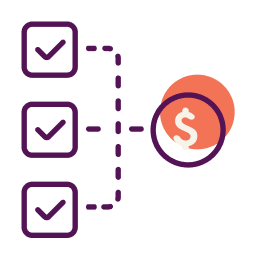You won’t have a business without sales. But to have a truly sustainable business, you need more than just enough cash in the bank to pay your bills. Good business financial health allows your business to thrive and, if you choose, continue to grow.
Here’s how to understand and improve your business’s financial health.
Why Is Small Business Financial Health Important?
When you’re feeling healthy, everything is easier than when you’re not well. It’s the same thing when your business is healthy; you’re better able to handle challenges that arise.
It’s also easier to get financing or attract investors when you have a financially healthy business. If you decide to sell, you’ll likely find it easier to get a buyer.
Here’s how to make financial health part of your business strategy.
What Determines the Overall Financial Health of a Business?
You don’t have to rely on a gut feeling to determine if your business is healthy. There are common business metrics and financial ratios that are used to understand the health and viability of the small business.
Here are several ways small business owners can get a better understanding of the financial health of their businesses using financial data.
If the following information makes you feel overwhelmed, don’t worry. In a moment, we’ll offer tools and strategies to make it easier.
Profitability
As a business owner, the first thing you want to do is to create a business that is profitable. At its simplest level that means you’re making money. But there are actually several types of profitability ratios that can be used to analyze business profitability: gross profit margin, operating profit margin, and net profit margin. Each will contribute unique insights into your business health.
Analyze the balance sheet
The balance sheet presents the businesses’ value at a given point of time. It reports the company’s assets, liabilities and owner’s equity. The basic formula is typically assets = liabilities + owner’s equity.
Liabilities include what’s owed by the business, such as loans and leases, but it will also include current liabilities such as rent, tax liabilities and payroll expens
Assets include things of value the business owns. It can include not only cash in the bank, but also accounts receivable, inventory, and real estate. Intellectual property can also be an asset.
Owner’s equity is whatever is left over after liabilities have been accounted for.
Income statement
An income statement (also called a “profit and loss statement”) will provide insights into the businesses’ income and expenses over a specific period of time. It can help you understand whether your business is making money (or losing it.)
You can make your own income statement or generate one from your bookkeeping software. Either way, your overall goal will be to compare income and expenses. In the income category you can have gross profit (revenue minus cost of goods sold), operating income (gross profit minus operating expenses) and net income (income before taxes).
Analyzing your income statement gives you the opportunity to evaluate whether increasing revenues or reducing expenses can help improve the financial health of your business. It can also alert you to situations where your business seems to be making more money but profitability is decreasing. And it can help you monitor the financial performance of your business over time.
The importance of cash flow management
How you handle cash flow will be key to how healthy your business is. A business that makes a lot of sales but struggles to collect payments, and consistently pays its own bills late as a result, may not make it in the long run.
Healthy cash flow means bringing in revenue with sufficient time to allow your business to pay employees, suppliers, taxes and other obligations on time.
Unfortunately, slow cash flow is a frequent problem for small businesses. There are several ways to measure cash flow. Among them, free cash flow is popularly used to determine the cash inflows available to pay debts, as well as to pay interest or dividends to investors.
After increasing profitability, improving cash flow can be one of the most important ways to impact your business.
Liquidity: What it is and how does it matter?
Liquidity for a business often refers to how easily assets can be converted to cash in order to meet short-term financial obligations, meaning those due in a year or less. Without liquidity a business may find itself in a situation where it can’t pay those bills and may be forced to borrow or even to default.
What Is the Difference Between Cash Flow and Profit?
Cash flow is the flow of money in and out of your business during a specific time period — so it’s a track of your income and your expenses. Your business’s cash is never stagnant, so it’s important to track cash flow so you know whether it’s positive or negative. Positive cash flow means there’s more coming in than leaving your business, while negative is the opposite. Businesses create a cash flow statement to track cash flow.
On the other hand, profit is the amount of cash left over after subtracting all of your operating expenses. Profit can also be positive or negative, and a negative profit is usually called a loss.
It’s important to understand both profit and cash flow and how they work together in your business. They can give important insights into the financial health of small businesses and educate their financial planning.
Small Business Can Maintain Financial Health When They Incorporate Systems
Most business owners don’t start a business because they want to pour over financial statements— unless perhaps they are starting an accounting business! You’ll want to take advantage of systems and tools that will make it easier to monitor and improve the well-being of your business.
Select and stick with a financial management system
You’ll need to choose a financial management system that works for your business. At a minimum you’ll need three elements:
- Business bank account
- Business credit and/or debit card
- Accounting software
A business bank account should be the central hub for all the financial activity of your business. Business income gets deposited there and business expenses get paid from it.
Even if you use payment platforms like Paypal or Venmo, it’s wise to have funds from those accounts deposited into your business bank account so you have a central view of your business finances. This can also help when it comes to getting approved for financing as many lenders will want to review business bank statements.
Don’t commingle your business and personal finances. If you need money from your business to pay for personal expenses, pay yourself (either as payroll or owner’s draw) and then pay your personal expenses from your personal accounts.
A business bank account that provides insights into your business finances can help you identify trends and stay on top of your business health.
You’ll also need an accounting program. Even if you hire a bookkeeper, it’s a good idea to maintain your own access so you can check in periodically. If you need to hire someone else to handle your bookkeeping, you can change access without missing a beat.
Plan for the unexpected
Just as an illness or accident can be a setback for your personal health, your business will likely run into unexpected financial hurdles from time to time. A client that pays late (or never pays at all), inflation (!), a new competitor, a supplier that goes out of business, a lawsuit from a disgruntled customer, equipment that has to be replaced or purchased are just a few examples of the types of emergencies that can crop up.
To play for the unexpected you’ll want to prepare in three ways:
- Set aside cash reserves for emergencies.
- Line up access to capital before you need it.
- Maintain adequate business insurance.
You can’t avoid, or even plan for, every potential problem. But you create a safety net that makes it easier to respond when things do go wrong.
Access to capital
Virtually all businesses should have access to a line of credit. With lines of credit, you can borrow what you need (up to your credit limit), when you need it. They are ideal for short-term financing needs.
In addition, a business credit card can give you access to a line of credit.
In addition, you may need small business loans. For example, you may need a term loan to finance specific projects, commercial real estate loans or specialized financing like invoice factoring to advance funds from clients that owe you money.
What Is a Good Debt Ratio (and What’s a Bad One)?
A debt ratio measures how a business’s debt compares to its assets. Higher debt ratios mean a business has taken out more financing. Debt ratios help determine a company’s financial health. A good debt ratio is typically considered lower than 0.4. This ratio is often taken to mean the company is less risky in terms of debt.
On the other hand, a debt ratio above 0.6 is considered riskier, likely making it more difficult for the business to borrow money. Learn more about the debt-service coverage ratio here.
How to Make Financial Health A Priority For Your Small Business
Building a financially healthy business is a commitment. Just like getting in shape physically, creating routines and using available resources can make it easier.
Don’t be afraid to get help. Your accounting professional, or a free business mentor from SCORE or your Small Business Development Center can prove invaluable as you work on making it a priority. The payoff of investing in your business’s financial health can be a business that supports you and your family financially over the long run.
This article was originally written on July 29, 2022 and updated on March 28, 2023.


Have at it! We'd love to hear from you and encourage a lively discussion among our users. Please help us keep our site clean and protect yourself. Refrain from posting overtly promotional content, and avoid disclosing personal information such as bank account or phone numbers.
Reviews Disclosure: The responses below are not provided or commissioned by the credit card, financing and service companies that appear on this site. Responses have not been reviewed, approved or otherwise endorsed by the credit card, financing and service companies and it is not their responsibility to ensure all posts and/or questions are answered.